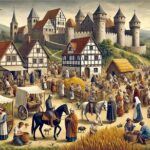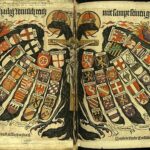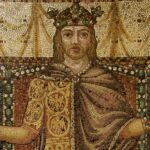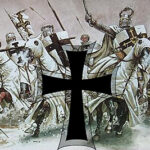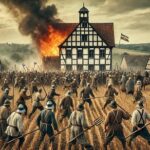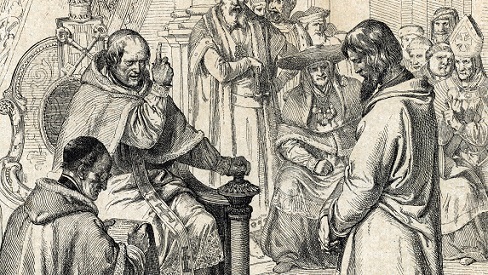
Imagine a powerful emperor standing barefoot in the snow, waiting for forgiveness from the pope he once defied. This iconic moment at Canossa in 1077 wasn’t just dramatic—it was symbolic of one of the greatest power struggles in medieval Europe: the Investiture Controversy.
The conflict between secular rulers and the Church over who had the authority to appoint bishops and abbots shook the foundations of German feudal society. What began as a question of ritual and rank turned into a decades-long showdown between kings and popes, challenging ideas of loyalty, divine rule, and governance itself.
Let’s explore what this controversy was really about, who the key players were, and how its legacy shaped the trajectory of medieval Germany and beyond.
What Is Investiture?
In the Middle Ages, bishops weren’t just spiritual leaders. They were powerful landowners and political figures. Whoever appointed a bishop essentially gained control over their lands, income, and loyalty.
Investiture refers to the formal ceremony of granting a bishop or abbot their office. It had two parts:
- Spiritual investiture: Handing over the ring and staff, symbols of church authority.
- Secular investiture: Granting the fief or territory that came with the position.
For centuries, Holy Roman Emperors had claimed the right to both—appointing church leaders who would support their reign. But a new movement within the Church said, “Enough.”
The Rise of Church Reform
By the 11th century, reformers were calling for a purification of the Church. Corruption was rampant:
- Many bishops bought their positions (a practice known as simony).
- Lay rulers (like emperors and nobles) routinely chose bishops for political reasons.
- Some clerics were married or living scandalously, breaking Church rules.
The Gregorian Reform Movement, named after Pope Gregory VII, sought to restore the Church’s moral authority. At the top of their list: end lay investiture.
In 1075, Gregory issued a bombshell document: the Dictatus Papae. It declared that only the pope could appoint or depose bishops—and that he had the right to depose emperors, too.
This was the spark.
Henry IV vs. Gregory VII: The Clash Begins
Henry IV, King of Germany and Holy Roman Emperor, saw Gregory’s reform as a direct attack on his authority. He responded by calling a council of bishops who declared the pope deposed.
Gregory retaliated by excommunicating Henry—cutting him off from the Church and releasing his vassals from their oaths of loyalty.
With rebellion brewing among the German nobility, Henry realized he had to make peace—fast.
The Walk to Canossa (1077)
In a now-legendary moment, Henry crossed the Alps in the dead of winter and stood barefoot in the snow outside the Castle of Canossa, where Gregory was staying. For three days, he waited in penitence until the pope lifted the excommunication.
It was a masterclass in symbolism:
- Henry preserved his crown—for now.
- Gregory appeared magnanimous and supreme.
- The Church’s moral authority soared across Europe.
But the war was far from over.
Years of Conflict and Civil War
Despite his submission at Canossa, Henry soon reasserted his power, appointed rival bishops, and installed an anti-pope. The conflict escalated into a civil war in Germany, with nobles split between imperial loyalists and papal supporters.
Henry eventually forced Gregory into exile. But the damage was done:
- Germany was politically fragmented.
- Noble families gained more autonomy.
- Church-state tensions burned hotter than ever.
Henry’s son, Henry V, inherited the throne and the fight. After years of deadlock, both sides were ready for compromise.
The Concordat of Worms (1122)
This landmark agreement finally ended the official Investiture Controversy:
- The emperor renounced the right to invest bishops with spiritual symbols (ring and staff).
- The Church agreed that bishops would be elected by cathedral clergy—but in the presence of imperial representatives.
- The emperor retained the right to grant bishops temporal power and land.
This compromise gave the Church spiritual independence while preserving some of the emperor’s political influence.
Impacts on Germany and the Empire
The effects of the Investiture Controversy were profound and long-lasting:
1. Decentralization of Power
German princes and bishops gained greater autonomy during the struggle. This contributed to the fragmentation of Germany into hundreds of duchies, bishoprics, and free cities that would persist for centuries.
2. Rise of Papal Authority
The pope emerged as a transnational power, no longer subordinate to secular rulers. The precedent of papal supremacy would echo in future Church-state conflicts.
3. Shift in Feudal Loyalties
As nobles chose sides, feudal bonds were shaken. Loyalty to the emperor could now be weighed against loyalty to the Church—and this blurred the lines of authority in medieval society.
4. Seeds of Legal and Political Thought
The controversy sparked debates about governance, rights, and legitimacy. Thinkers began to explore the limits of secular and spiritual power, influencing later theories of monarchy and constitutionalism.
A Human Story of Power and Principle
It’s easy to see the Investiture Controversy as a legalistic dispute—but at its core, it was deeply human:
- A proud emperor fighting to hold his realm together
- A reforming pope trying to purify a corrupt institution
- Bishops caught in the middle
- Peasants and knights watching loyalties shift around them
It was about control, but also about belief, identity, and the future of Christian Europe.
The Investiture Controversy redrew the map of medieval authority. It elevated the papacy, weakened imperial control, and turned Germany into a mosaic of independent powers.
It also marked the first major confrontation between church and state in Europe—a theme that would define centuries of history. From Canossa to Worms, the road was long, bloody, and transformative.
To explore how this controversy set the stage for future divisions, check out our featured articles:
The Middle Ages in German History – An overview of the political, cultural, and religious transformations that shaped Germany from the fall of the Carolingian Empire to the dawn of the Reformation, including the rise of the Holy Roman Empire and medieval society.
Otto I and the Birth of the Holy Roman Empire – Explore how Otto I’s coronation in 962 marked the formal beginning of the Holy Roman Empire, establishing a powerful political and religious legacy in medieval Germany.
Medieval German Feudal Society – Learn how landholding, loyalty, and class defined the social structure of medieval Germany, shaping both everyday life and royal authority.
The Hanseatic League – Discover the rise of this powerful trade alliance of northern German cities that dominated commerce across the Baltic and North Seas during the late Middle Ages.
German Castles and Knightly Culture – Dive into the architectural and chivalric world of medieval Germany, where fortified castles and knightly ideals shaped warfare, literature, and noble identity.
The Black Death in Germany – Trace the devastating impact of the 14th-century plague on German towns and villages, altering demographics, labor systems, and religious life.
Peasant Revolts in the Middle Ages – Examine the causes and consequences of peasant uprisings in medieval Germany, including their role in challenging feudal oppression and economic hardship.
The Teutonic Knights and Eastern Expansion – Follow the military and missionary campaigns of the Teutonic Order as they expanded Germanic influence eastward into pagan territories.
German Medieval Universities – Explore the intellectual revival of the High Middle Ages, as cathedral schools and universities flourished in German cities, preserving classical knowledge and fostering new ideas.

